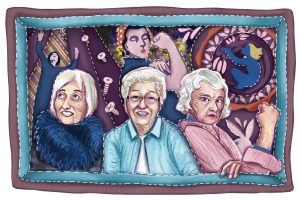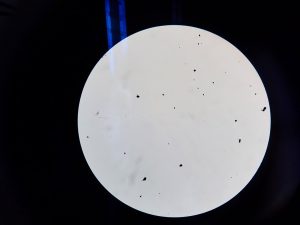Featured image: An installation view of Hannah Levy’s piece “Untitled,” 2021. Nickel-plated steel, silicone. 68 x 74 x 74 in. A chandelier-like sculpture that takes the shape of an exaggerated bodice. The bodice-shape is beige with a corset-like detail. Steel, arm-like, structures appear to be holding the shape in place. Another smaller steel sculpture by Hannah Levy can be seen in the background on the left. Image courtesy of the Arts Club Chicago.
Roland Barthes describes the striptease as a “delicious threat…a spectacle based on fear.” He conceives that, above all, a striptease is a contradiction: the instant of complete undress marks the frightening desexualization of the entertaining object—the object of sex being, and in this case (as in most cases) the “Woman”. A double negative.
This is what came to mind when I saw Hannah Levy’s work in her show Surplus Tension at the Arts Club of Chicago. Note that the tease is not spoiled here—yet. Rather, what is on display captures the edging and agonizing voyage to full disclosure—caught in a contended seesaw with the excess of visual desire on one end, and the obstinate labor of concealment of desire on the other. It is a kind of seesaw traced in Barthes’ theory; in it is a kind of fear oscillating between the objectification of the woman and her desexualization—though, the two are never mutually exclusive, and the fear in question seems to be a privilege that disconcerns the woman. Instead of teasing out this fantasized fear, Levy’s work vibrates with a different register of anxiety, reverberating in savory silence and seeping with quiet pleasures.
In Levy’s piece Untitled chandelier, the taut, resistant silicon embraces the unfurled claws of the metal chandelier, gesturing a tease in suspension. The tease is suspended in time and space, quite literally, through an articulate gesture of anxiety—between realms of pleasure and repulsion, pressure and release. It configures a very delicate line, drawn as a race against time, infinitely prolonging the supposed operative negation of flesh under a striptease, as Barthes suggests. The laced up back of the corset remains intact, unconstrained, transparent. The tension is to be located elsewhere.
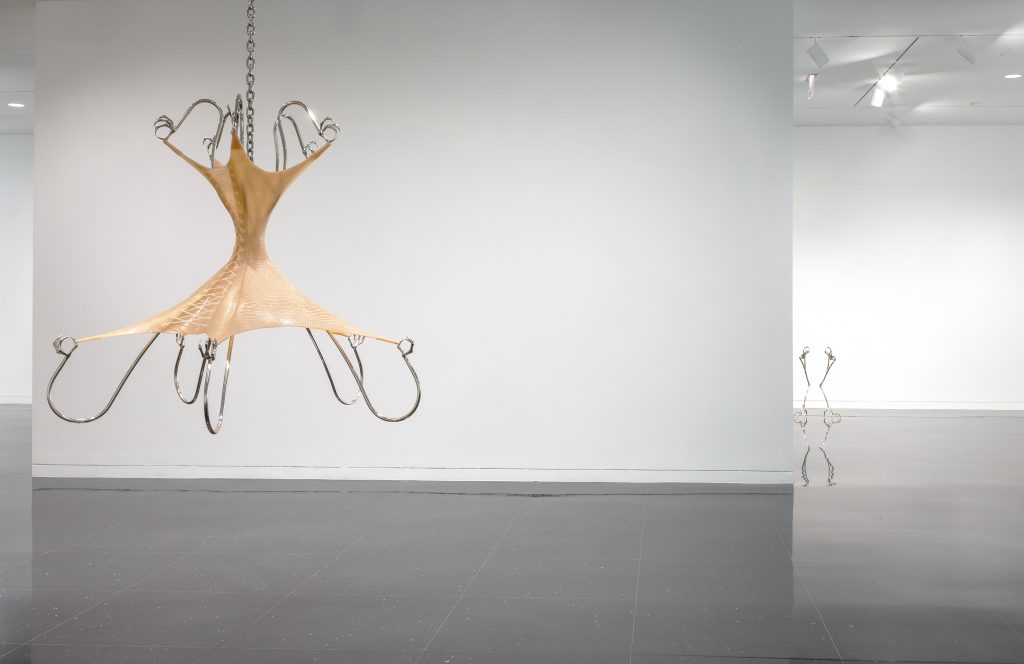
Instead of playing into the negation, the Untitled chandelier at the entrance of the space proposes a mutation of the flesh, a refabrication and a reconfiguration, materially and metaphorically. The chandelier is suspended from the ceiling on a comically large chain that runs through the silicon bodice; the edges of the corset are stretched out by the elongated claws from under. The point of contact is clenched in a threatening state of petrification. All the tension held and allowed in the elasticity of the silicon canopy seems to be on the threshold of breakage, hanging onto the tips of the metal claws. But the two are linked through tiny hoops girdled by the silicon and hooked onto the claws. Protected danger. A delicious thrill, cradled in an unapologetic gesture, leveraging tension to the conceit of restraint.
When asked about a primary visual memory for her work, Levy recalls memories of sensation instead. Like the feeling of leather sticking on your legs when you go for a drive on a hot summer day, Levy recounts a muted seduction, vivid and specific; a resonating sensation that eludes our daily language or thought. It seems as though it is not just a mere chandelier in suspension, but a ghostly presence of “pleasure” that hangs in the air—just slightly out of reach, sitting in the back of language and discomfort, something we can’t quite put a finger on. Levy works with this unnamable realm of sensations, articulating them through the extended claws of the sculptures, seizing “pleasure” in its assigned backseat of the sensual and sensorial, and placing it right into the driver’s seat of the visual. The seatbelt is fastened, so as not to spill. The shotgun is called by the unnamed.
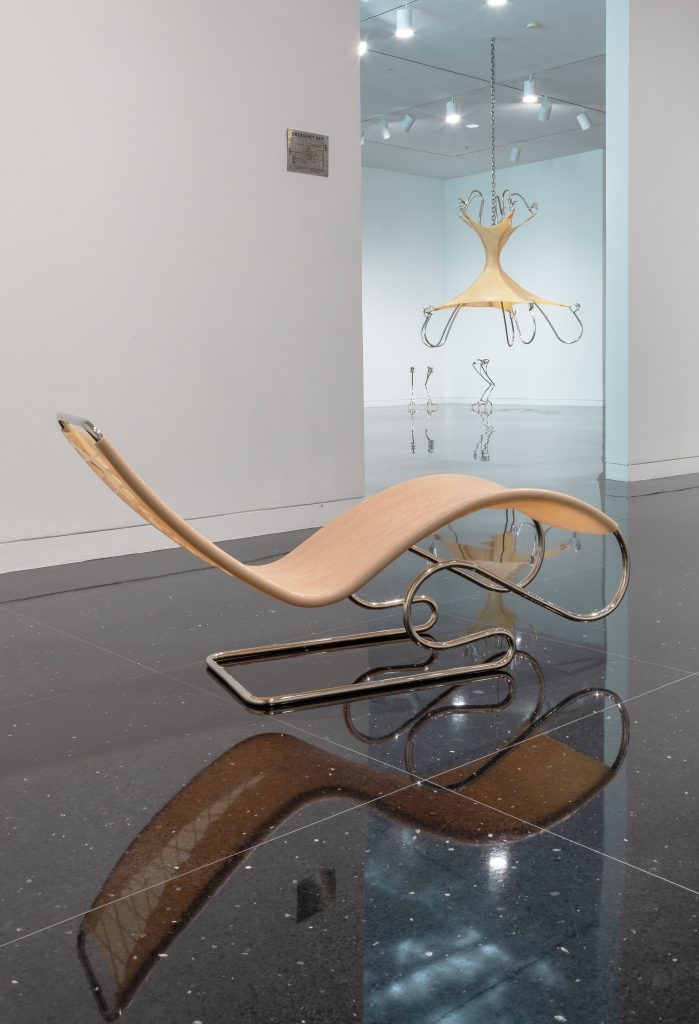
In the poetics of the unnamed, untitled, and the unpronounceable, Levy also teases out the ghosts of the given art space. When researching for the project in the Arts Club, Levy was drawn to a delicate and unexpected detail on the MR10 cantilever chair by Mies Van Der Rohe (the interior designer who defined the early aesthetics of the Arts Club)—the laced up back. In Mies’ chair, leather is stretched over its tubular spine and laced neatly at the back, imitating the tactile tensions used in a bodice. Coming from a Bauhaus lineage that fashioned masculinity in robust minimalism, Mies’ choice of lacing the back seems anomalously feminine, yet rigid. In the laced back, this corset-like detail, Levy finds the creative entry to alter, amplify, and assert a female presence. In her Untitled lounge chairs showcased in Surplus Tension, Levy presents us with a set of chaises lounges gloved in silicon, a reinterpreted version of Mies’ MR10, but with slouched backs that are laced, stretched unevenly. The chairs are peculiarly sized to deceive its function, or shall we say, to the function of deception: the backs are sloped just too much for sitting, but just enough to reflect the lacing detail on the terrazzo floor beneath, configuring a sexualization of the object and an unexpected reappearance of the feminine on the underside. Levy laces the sculptural with the sensual, the behind-the-scenes with a deliberate mise-en-scene. The tempo of “function” is offset in the sonic of “desire”, in a playful bodice, which conceals as much as it divulges, fluctuating between the hard and soft, the industrial and the organic, underlining the ellipsis with a surplus.
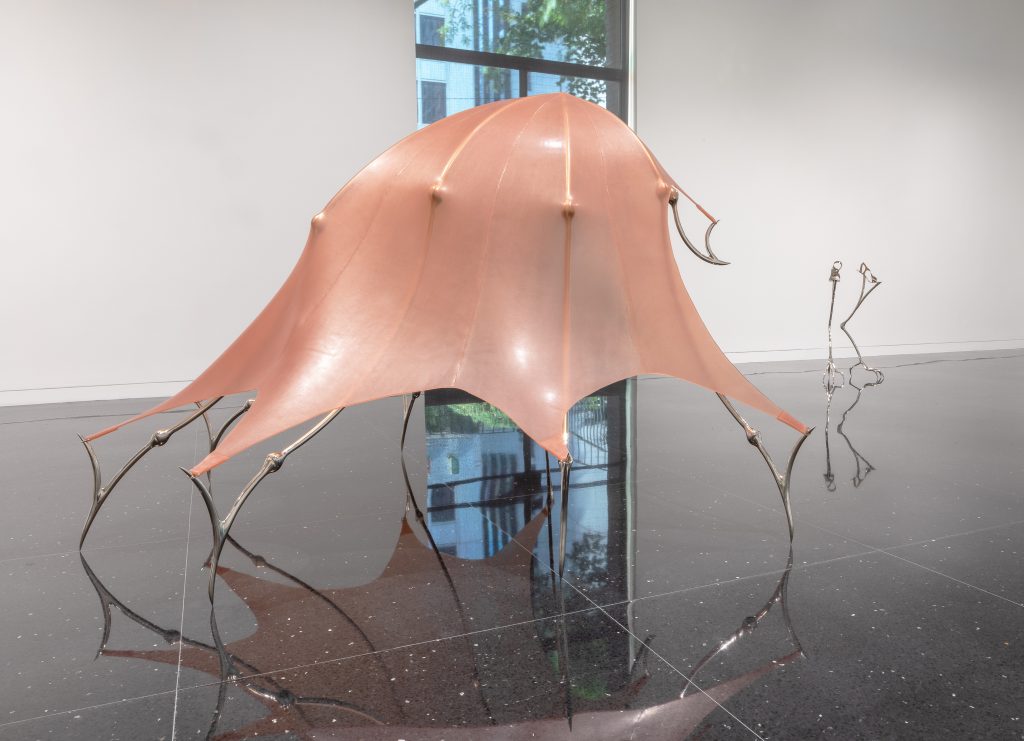
To the right side of the exhibition space, a crinoline-like structure is caught stretching its legs against the mirror-like floor, almost slipping. The points of contact with the floor are welded and sharpened to a focus, congealed on the fine tips of the claws, creating a continuous line that carries the objects past their confines and into their shadows—shadows that slip into reflections, a doubled presence with equal weight. Leveled tension. Coated in semi-transparent, salmon-colored silicone hooked onto the spokes, the underskirt of the piece is exposed, from out and under. Levy coats the steel structure with a second skin, which acquires for it the semblance of the underside of bat wings. Nocturnal creatures, uncovered and distorted, disturbed, with joints seeking to protrude out of the skin that withholds. Against the Untitled anamorphic spider-underskirt stands a set of metal ostrich-like legs. The top of the piece is arched to the shape of a footbed attached with silicone sandal straps. Feet in disguise. Shoes to hide in.
“Tension” in the title seems most poignant at the contact point between the elastic entanglement of the materials and the surgical treatment of the sensual—at the cartilage, eliciting fluid motions. The sculptures stand ever so enticing, withholding an air of decency that declines any invitation to trigger or activate. An excess of desire precipitates, overcoming its intangible confines through sensational cracks gestured by the sculptures, washing over the floor of reflections and finding its point of leakage in us, the moving bodies and shifting eyes.
The private is caught wandering in public, as the strange confronts the unexpected intrusion of the familiar. Are the chairs for sitting? Can you wear those shoes? Is the underskirt of the chandelier to be peeked through? Voyeurism is being teased, as well as the conspiracy of sexualization and objectification inherent to the tease—a game we all tacitly play in our culture today.
The tacit game solicits a quiet restraint on our movement. As the space is slowly taken up by the quiet palpitation of sensual impulses, we find in ourselves an urge—a compulsion to touch, to feel, to trigger the fragile structures, to come closer, to embody and realize the spectors of unnamed desires through a tactile relationship. The tensions underneath the immobility of the objects are performed in the choreographies of the passers-by, the viewer, the “I”. Captured by a surplus of sensory stimulation and bodily constraint, the viewers need to lead the dance, a dance around the tensions besieging and overwhelming us with silent assertions. In a space of poised fragility, an improvised agility is enlisted to liquidate the space between objects and subjects, pains and pleasures, desires and compulsions, and into a fluid matter of suspension—like a smell in the air, a slippery chair, a provoked chandelier, on the tip toe.
What follows is a conversation between Hindley Wang and Hannah Levy, taking place virtually after Levy’s artist talk on December 8, 2021 at the Arts Club Chicago.
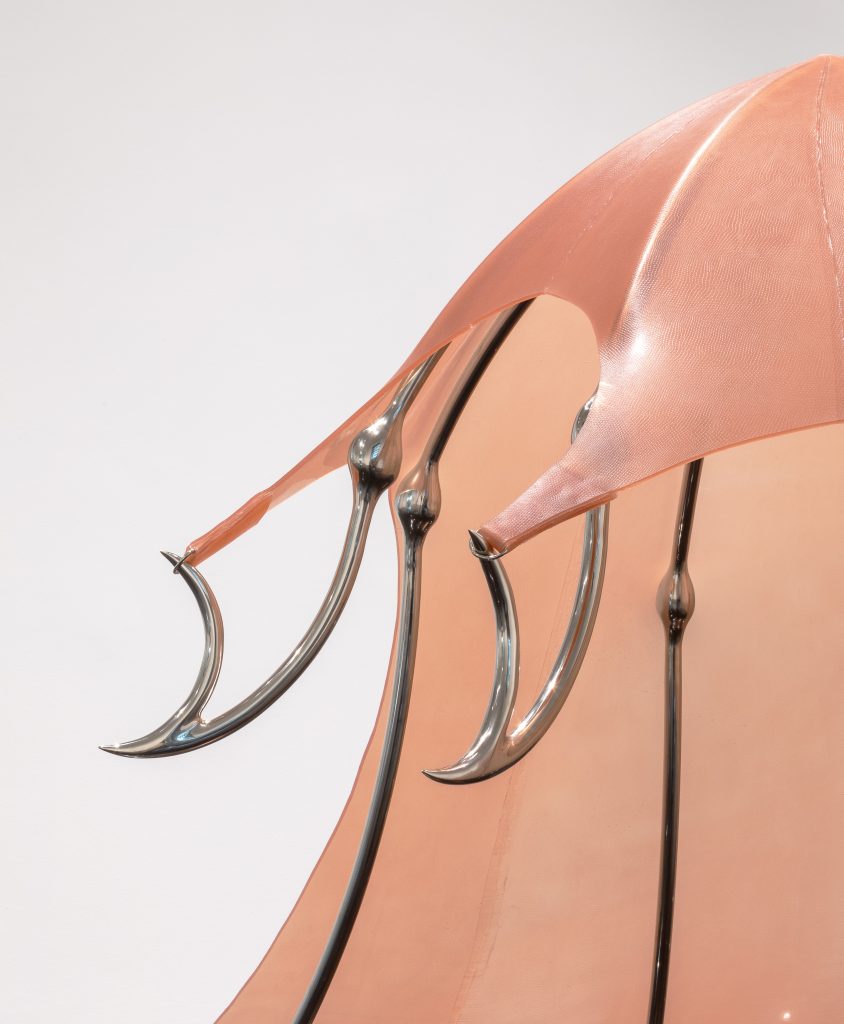
Hindley Wang: So much of your work is about constraint and tension, but there is a play with the superfluous, the hard-to-pin down sensations that escape everyday language—what we don’t talk about or perhaps don’t have the language for anymore. Does this tension have anything to do with the fact that all your works in the exhibition Surplus Tension are untitled? Or perhaps on naming pleasures and unnamed pleasures?
Hannah Levy: Yes, I think a lot about pleasure and sensation in my work for sure—sensations that can go to pleasures or somewhere else. Sensations that you’re kind of ambivalent about, or good in some way and bad in some way. But the idea of this kind of tension between pleasure and restraint is the easiest to pinpoint. The part of my work that deals with that is maybe the desire to touch it, or the fact that [the work] is always shown in a context where you can’t. So by the nature of existing in an art space, the work is playing with pleasure and restriction in a certain way. [Regarding not titling my work], one way to read it would be to [relate it to] withholding in some way. But it’s more that I feel like giving a work a title forces a single reading—a more narrow reading of the work. I hope to make objects that have a whole lot of different associations. On the rare occasion I do give my work a title, I usually name what the object is, like the piece I have on the Highline right now. I didn’t want to leave it untitled, because it exists in a public park, where the word “untitled” ends up feeling very pretentious to a non-art audience. So I just called it “Retainer,” which is what it is. And I also like that that word has a sculptural quality; it’s about the action of retaining something, an action that is made into a noun.
HW: This is so interesting—the word retainer feels almost like a departure point for thinking/conceiving a project. I am curious whether this is one of the ways you start thinking of an idea, from a word? Or a feeling?
HL: Definitely more with a feeling and a visual than a word. The fact that the word is also sculptural came as a second layer, not something I was thinking about in the beginning.
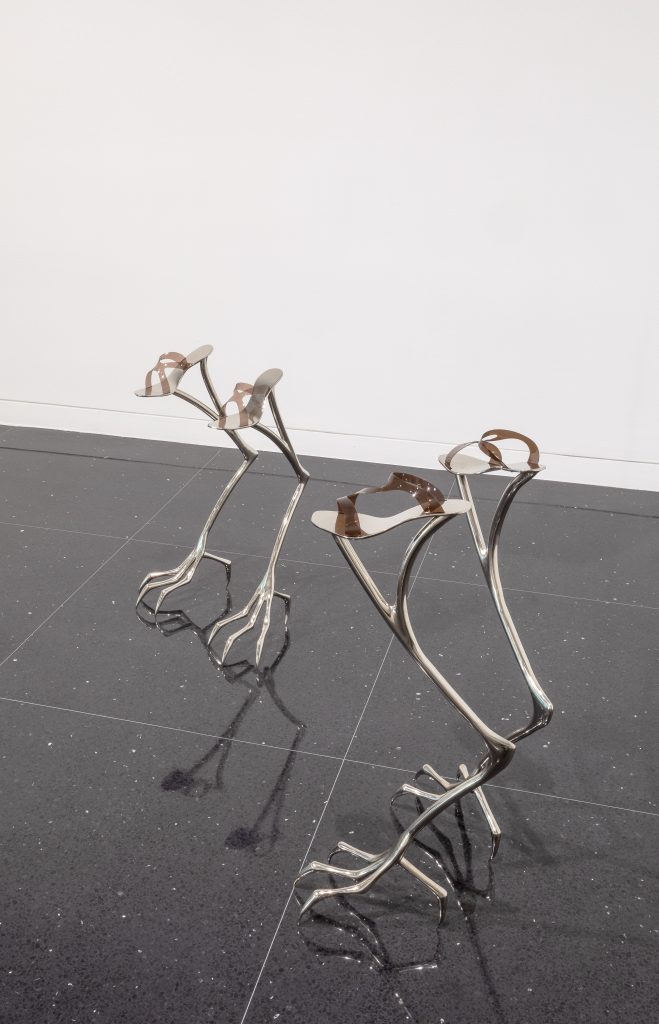
HW: Right. I was thinking in line with how we name things in our daily life, and how the naming sculpts our relationship to the objects, how the objects sculpt us, and vice versa. Like the chairs in the exhibition and how they demand a certain position and posture from us. The other idea that I wanted to ask you about is the “underside”. You’ve explained how you worked with the reflectiveness of the floors in the Arts Club to the advantage of exposing what’s otherwise unseen. How does that idea inform your practice of working with highly contrasting materials?
HL: I guess “underside” and the material juxtaposition are two different things to me. The two materials come together—one is often soft and one is hard, and the soft one often becomes a bodily stand-in because, like you were saying with the way that we interact with the chair, most of the objects that I choose to work with have a kind of bodily interface to them. They are objects that we understand how they feel or that we are used to touching—we as humans are usually the soft things that come into contact with them. So when I am combining the two materials, I am thinking about sensory moments and trying to recreate them as sensory sensations that you are able to get a visual understanding of from the object. And [the chair] is really a beautiful, simple sculptural tool to put the hard thing with the soft thing [i.e. our body] together in juxtaposition.
So the idea of the underside is not really connected to the juxtaposition. When making a sculpture, unlike painting, the underside is always a part of it, because it is an object that is understood three dimensionally, rather than a 2D surface. So with the sculpture, you always have to be aware of all sides. When I make something and have it photographed, there are angles where I know it will look best at, but that’s about translating a 3D thing onto a 2D surface. The Arts Club is a bit different because of the reflective floor, in that I have the opportunity to think about the underside in a more literal way; [the underside] is a thing that will be visually seen, because all the work is basically standing on a mirror. I am always thinking more about the experience of the viewer and what you all are able to see. When I am trying to decide how tall a piece should be, I am thinking about where this is in relation to the average viewline. For example, with the chairs on display, if I had them on display somewhere else, I would have designed the angle of the back of the chair a little sharper, so that the corset detail could be seen standing. So it is less about the underside as a concept and more about the physical reality of [a piece] existing in a given space.
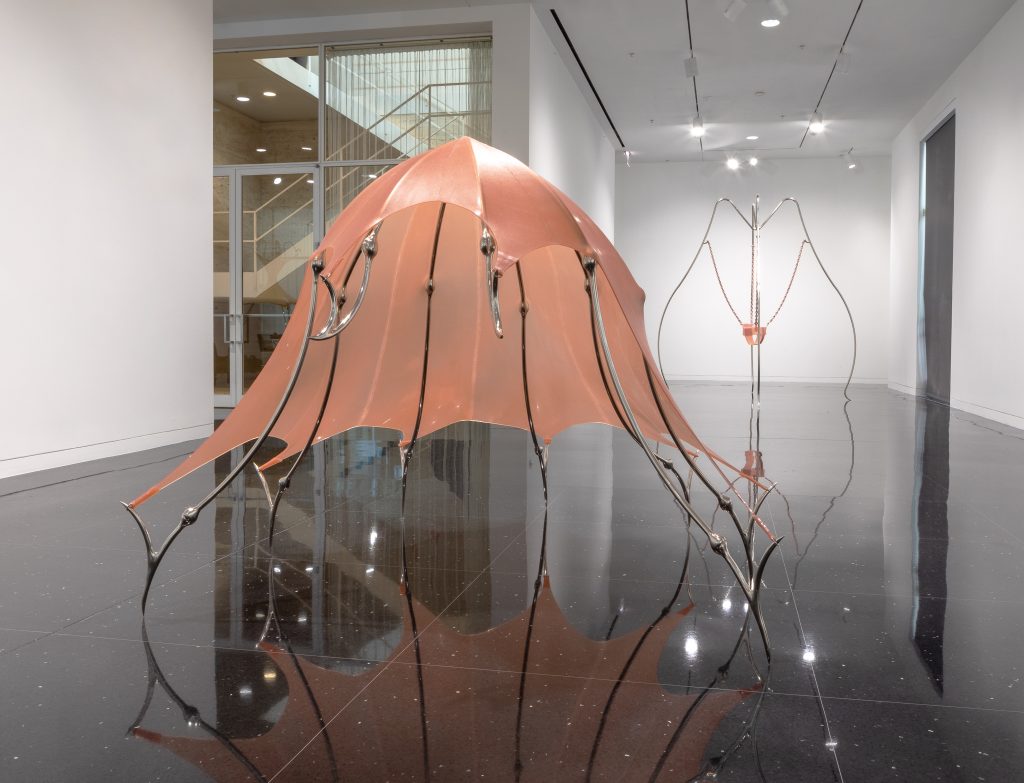
HW: That just brought to mind another point that I was thinking of for the chandelier piece. I was watching this episode of Chicago Med where they were hanging this perilous looking chandelier, and as it gets higher, you just know that something is going to happen. I was thinking about the suspension of a structure like the chandelier and the kind of danger looming overhead. It should be the easiest to see the underside of the chandelier, but your chandelier is leveled so low to the ground that it is a bit hard to bend over and look up from under it. At the same time, the piece is not making contact with the “mirror” floor to create the elongation of the lines with its reflection, as present in the skirt, or the legs…
HL: This is the fourth chandelier that I have made. The first three were with my gallery in New York, Casey Kaplan. It has a 14ft high ceiling, as does the Arts Club. For an average apartment space, the ceiling height is usually 8ft, so 14 is very tall and glamorous. But when you put a chandelier that is 6ft tall in a 14ft space, it takes away the tall glamor. It is just something that is too big for the space, but you’re working with a space that is already pretty big, so there is some kind of a play there. Again, I always think about hanging those at eye level. In continuing the “upskirt” idea of that specific shape at the Arts Club, you kind of don’t need to bend over to look under it because of the reflective floor underneath. I like the idea that it is at a height where you don’t see “under the dress,” but it is easy to see it if you choose to—all you have to do is bend over a little. It’s something very available to the viewer if they so choose, but it gets them in a position that’s maybe a little pervy in a way. It is a fun moment to play with and tease at.
HW: My last question has a little more to do with the underside again. Looking at your work, I almost forget the fact that there is so much calculation and measurement that goes behind something so sensual in presentation. You talked a lot about “gesturing” in your artist talk, but there is so much more labor when making a metal sculpture than if it were a painterly stroke. How do the technicality and practical processes behind your work inform your understanding of the sensual and the sensory?
HL: I’ll have to think about that one as I talk. I think you’re definitely onto something when you’re talking about creating a gesture. A lot of the time, my goal is to create something that feels gestural and playful, but the actual process of making that thing requires a lot of planning and step by step action. It’s like, if I want the hand to look like this [gives a hand gesture of ‘ok,’ as seen in the claws in Untitled chandelier], I’ll have to weld three pieces of metal for each finger, then carve and sand each finger, and then weld them together. So for a hand like this, it will take me a week of 12-hour workdays. It’s a process that takes a very long time. Even if I am making something light and goofy, I have to really commit to that lightness or goofiness for a while before I get there. And sometimes that feels a little silly, but the whole process of making an artwork is easier for me to not take it too seriously and to always think about and laugh at myself for putting so much time into making a piece of art, which is a pretty ridiculous thing in and of itself. And in order for me to make sculptures that are so labor intensive, I also have to be able to see the humor in that.
Surplus Tension is on view from September 30, 2021 through January 29, 2022 at the Arts Club Chicago.
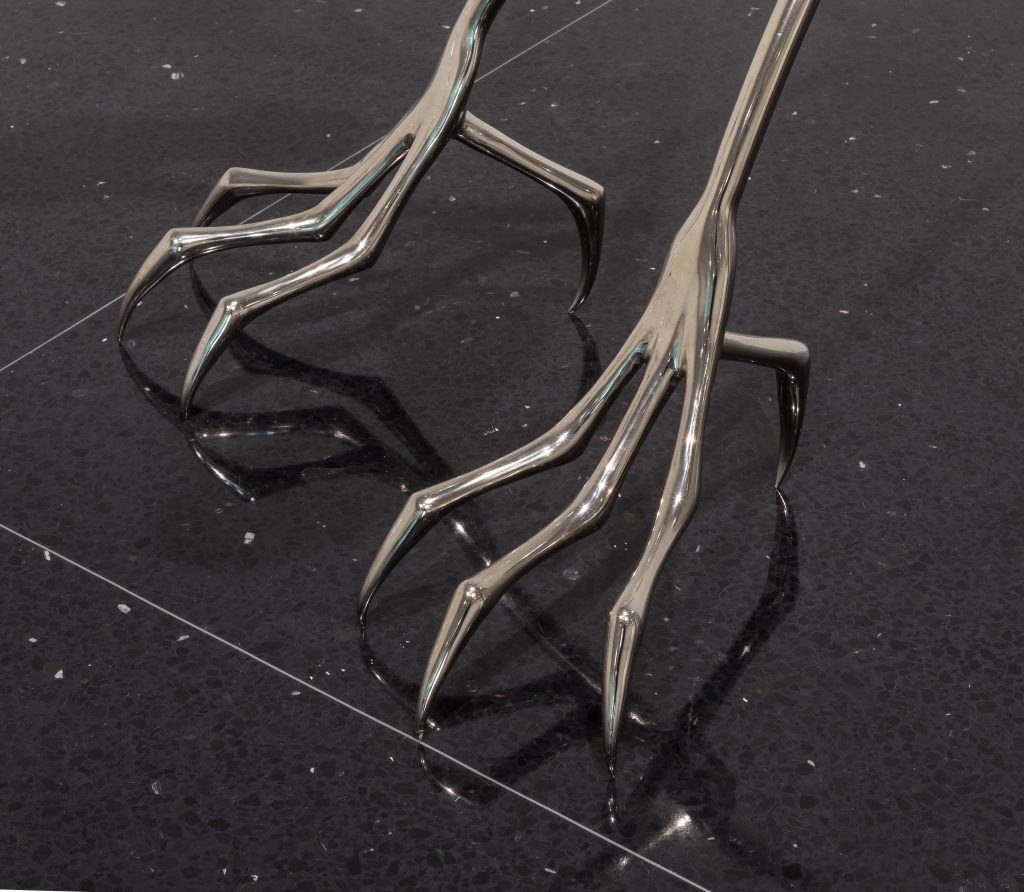
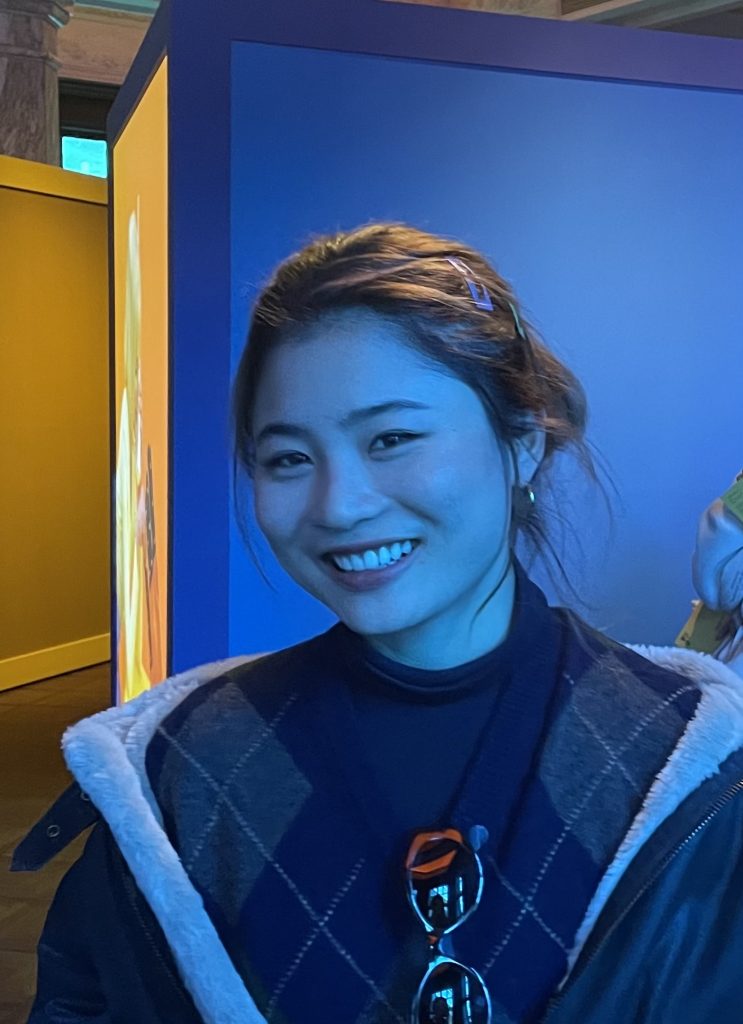
Hindley Wang is a writer currently based between Chicago and Shanghai. She is interested in transcultural practices and discourses in aesthetics and politics, weaving through global entanglement and postcolonial futures. She is currently working on her MA in Art History at the University of Chicago, and she holds a BA in Art History and Political Science from Vassar College.


